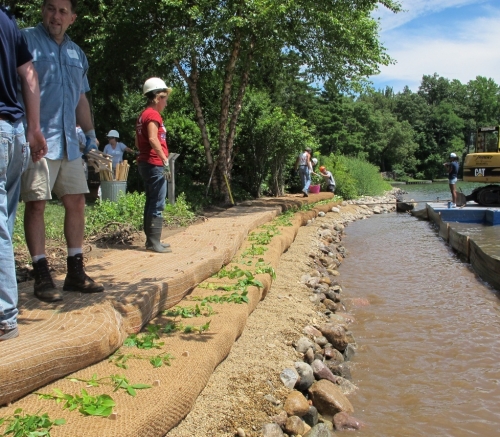Inland lake shoreline erosion control demonstrated at Kellogg Biological Station
Updated website offers video of the rebuilding of an eroded bank on Gull Lake using encapsulated soil lift technique.
Encapsulated soil lifts on a rock base were used to rebuild an eroding bank at the Shoreline Management Demonstration Area at Michigan State University’s Kellogg Biological Station (KBS) on Gull Lake in northern Kalamazoo County.
Lakefront property owners may consider this technique as a possible solution to eroding and collapsing banks on moderate to high energy properties. It involves the encapsulation of soil in biodegradable blankets that is formed into layers. The layers, or lifts, are stacked up the bank – stepped back to create the desired slope – and then seeded or planted with native wildflowers, grasses and shrubs. Properly stabilized or rebuilt banks can reduce soil erosion into the lake – protecting water quality and fish habitat.
The project was funded by the Michigan plant industry’s Project GREEEN along with other supporters. It provided Certified Natural Shoreline Professionals with hands-on continuing education on the construction of two kinds of encapsulated soil lifts. The project, constructed in 2011, is being monitored to compare the two kinds of lifts for plant establishment, resistance to invasive species and performance against wave and ice action. The project was permitted by the Michigan Department of Environmental Quality’s Part 301 Inland Lakes and Streams program.

Newly constructed encapsulated soil lifts on a rock base at Kellogg Biological Station
Project GREEEN is also funding the ongoing update of the popular www.shoreline.msu.edu website which focuses on the entire KBS demonstration site. Constructed in 2001 and 2002 with the support of many partners, the KBS Shoreline Management Demonstration Area is the most mature natural shoreline demonstration in Michigan. This 400-foot long site features four different shoreline landscape designs that vary in their use of native plantings, ornamental plantings and seedings. The site also includes multiple erosion control structures, suitable for moderate to high energy shorelines, including rock riprap, live crib wall, vegetated geogrid and encapsulated soil lifts. The updated website includes a short video of the 2011 soil lift project with a step-by-step overview of the construction process.
For additional information on natural shorelines and for upcoming natural shoreline education events, please visit the website of the Michigan Natural Shoreline Partnership.



 Print
Print Email
Email


